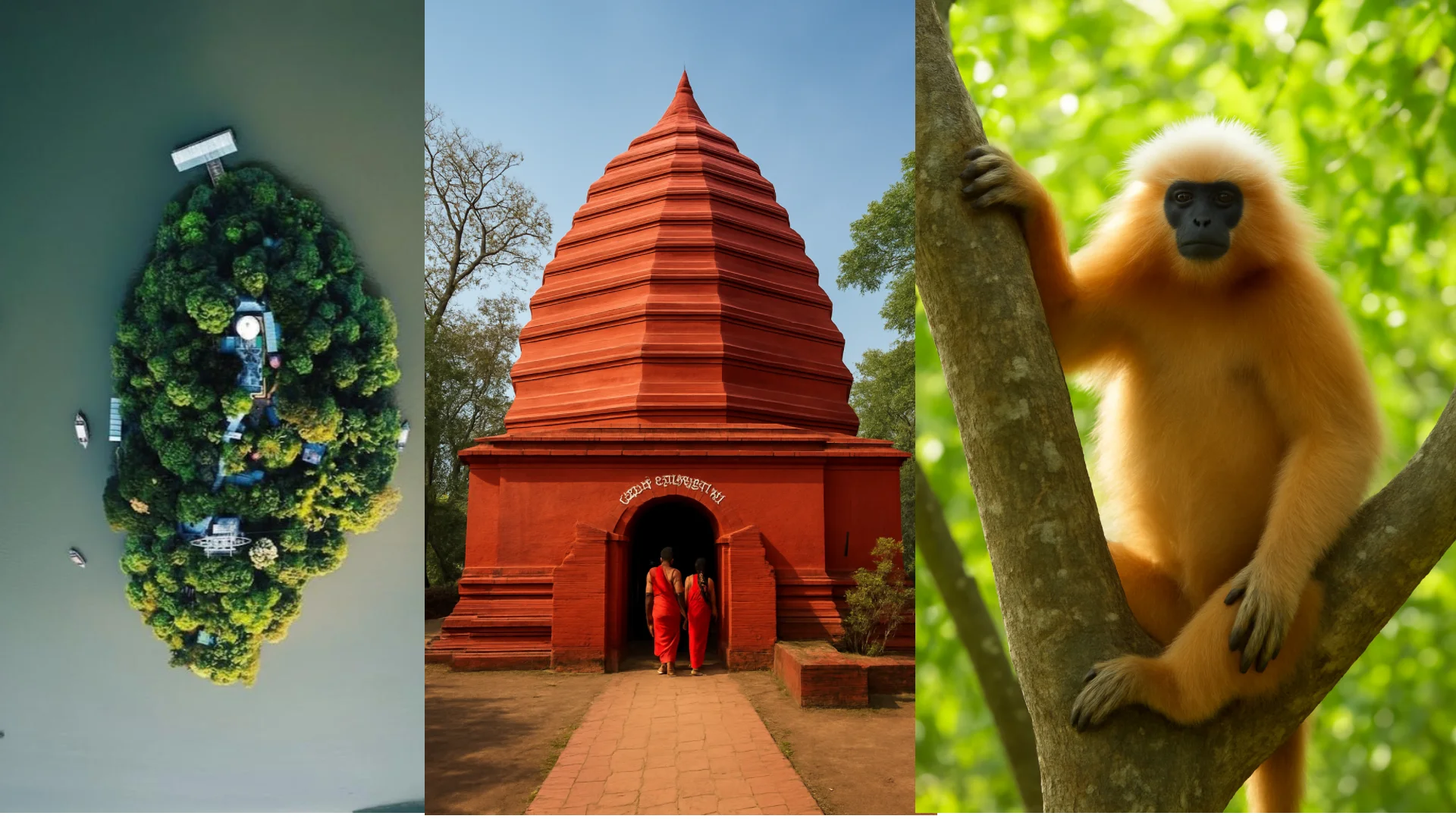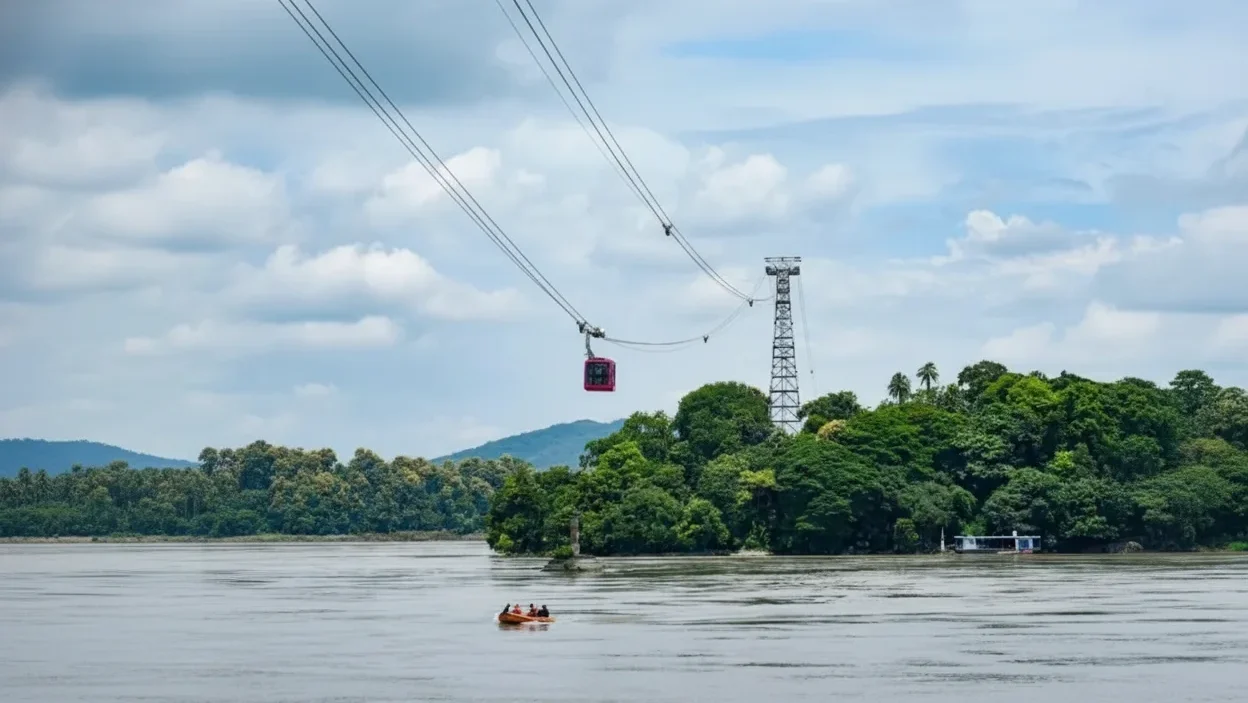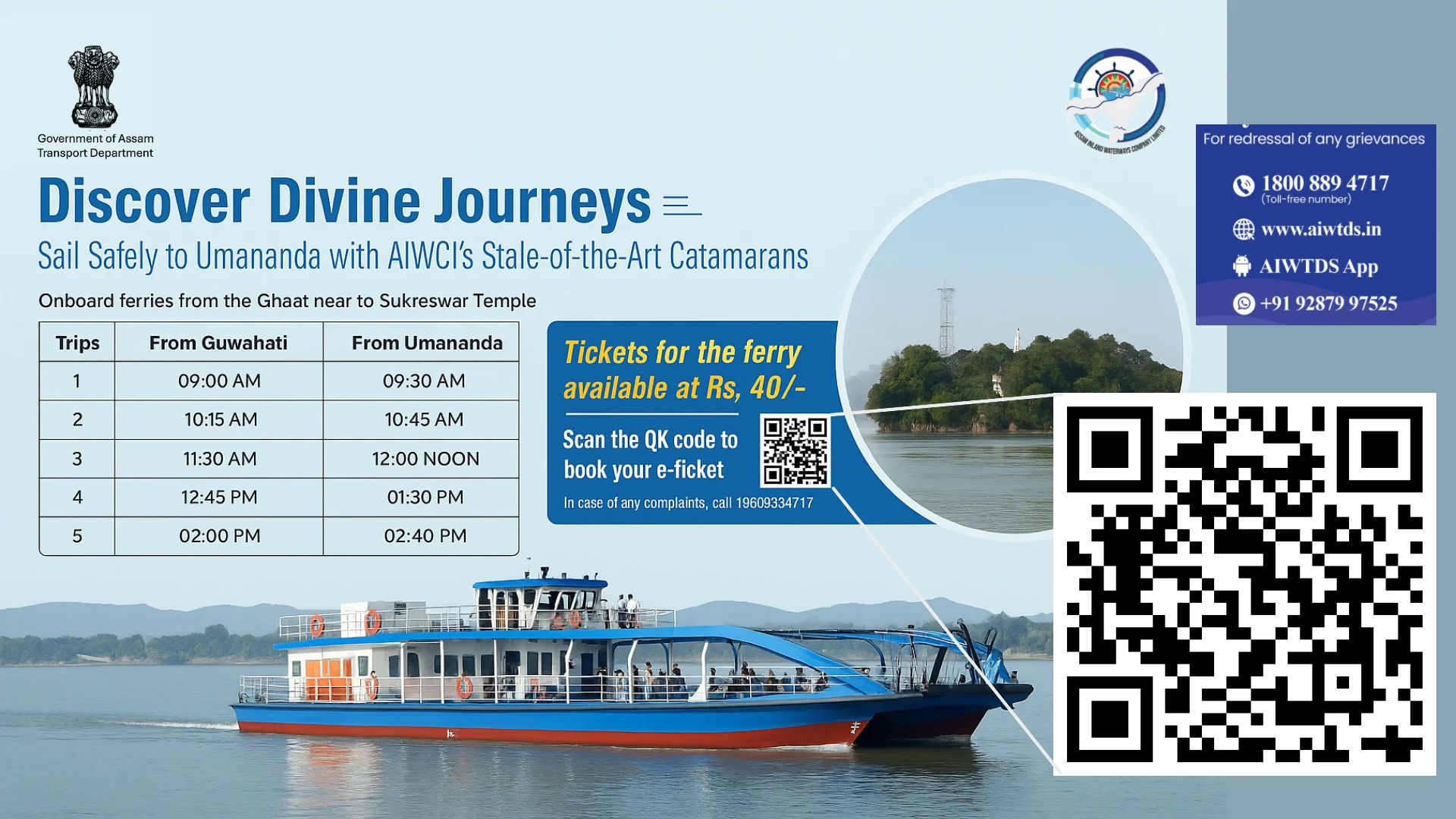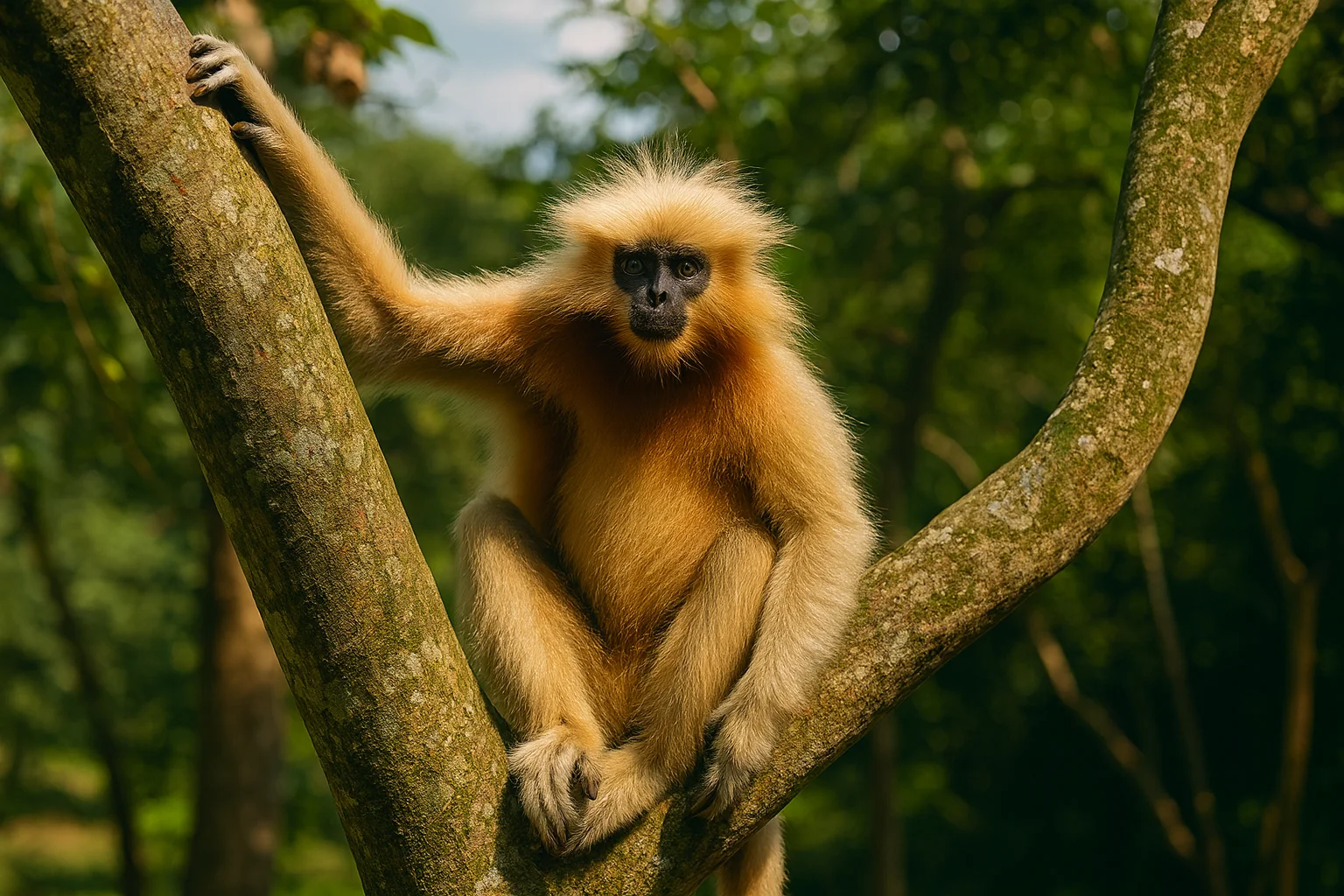
The Mystical Umananda Island (Peacock Island): A Hidden Gem in the Brahmaputra
The sacred Umananda Temple, which is situated on Umananda Island popularly known as Peacock Island, is one of the most famous Shiva shrines of Guwahati and Northeast India. The small island lies right in the middle of mighty Brahmaputra River, surrounded by calm waters, greenery all around, and hills in the far distance.
Umananda happens to be Assam’s smallest inhabited river island blessed with mythology, nature, and religion at one place that very few destinations can offer. From ancient tales about Lord Shiva to stunning aerial views from the Guwahati Ropeway, this island gives an experience that feels both magical and very real.
This guide will help you with everything you need to know before stepping into such a beautiful paradise whether you are a spiritual seeker, history enthusiast, or nature lover.
The History and Sacred Legends of Umananda Temple
A Temple Created for the Bliss of Goddess Parvati
As per ancient Hindu scriptures, Lord Shiva created this island as an abode of peace for Goddess Parvati (Uma). The name Umananda is derived from the combination of “Uma” (Parvati) and “Ananda” (joy), which means “the bliss of Parvati.”
For centuries, the island has been regarded as a sacred space where spiritual energy, mythology, and nature exist in perfect harmony.
Built in 1694 by Ahom King Gadadhar Singha
The present Umananda Temple was built in 1694 AD by Ahom King Gadadhar Singha, one of the mightiest rulers of Assam. Bar Phukan Garhganya Handique supervised its construction. The temple has beautiful rock-cut sculptures and engravings made by Assamese artists.
They are:
- Lord Shiva
- Surya (the Sun God)
- Ganesha
- Devi
- Lord Vishnu with his Dashavatara (Ten Incarnations)
This makes Umananda one among the best examples of medieval Assamese temple art.
Bhasmachal Hill — The Hill Where Kamadeva Was Turned to Ashes
Umananda Temple is located on top of the Bhasmachal Hill, which is also known by the name of Bhasmakuta. Legend has it that Kamadeva once disturbed Shiva when he was deep in meditation. In his anger, Shiva opened his third eye and turned Kamadeva into ashes on this hill.
It is from this event that the hill derives its name: “Bhasma” meaning ashes and “achal” meaning hill.
Urvashi Island – A Name from the Kalika Purana
Another interesting legend is that which has been recorded in the Kalika Purana, according to which the Goddess Urvashi brought Amrita for the Goddess Kamakhya and had her abode here. So Umananda was called Urvashi Island, adding another aspect to its divine history.
Destruction and Reconstruction After the 1897 Earthquake
A large part of the temple was destroyed during the great Assam earthquake of 1897. Later, a rich local trader rebuilt the destroyed parts and added some Vaishnavite inscriptions in the sanctum area. The combination of Shaivite and Vaishnavite features makes this temple architecturally interesting. Please remove shoes before entering the temple; no photography inside sanctum during prayers and heavy crowd movement.
Tip for Visitors: Respect the sanctity of the temple—remove shoes before entering and avoid photography during prayers.
Stunning Aerial Views of Umananda Temple: Drone & Guwahati Ropeway Perspectives
Seeing Umananda Temple from above is absolutely stunning! Whether it’s through the glass cabin of Guwahati Ropeway or a drone flying high above the Brahmaputra, those bird’s-eye views really show off the true beauty and size of Peacock Island—something you just can’t see from ground level.
Aerial Drone Perspective: A Rare, Unmatched View
Your drone shots give an overhead view, showing clearly the small shape of the island, where the temple complex is located on Bhasmachal Hill, and how the currents of Brahmaputra swirl around it. This angle brings a clarity and detail that travel guides rarely capture—making your visuals both exclusive and invaluable to visitors.

Aerial Ropeway View: The Iconic Approach
The Guwahati Ropeway, India’s longest river-crossing cable car, also offers an impressive elevated perspective of Umananda—especially as the cabin glides directly over the Brahmaputra.
From here, visitors can admire:
- The temple complex nestled atop the hill
- The lush tree cover across the island
- Ferries docking at Umananda Ghat
- The expansive river stretching toward the Guwahati skyline
While ropeway views are mesmerizing, your drone images allow readers to see angles and details even the ropeway cannot fully offer.
A Unique Fact: Ropeway Pillar T3 Sits on the Island
Very few people know that there are five supporting pillars for this ropeway and one of them—the central pillar called Pillar T3—is built directly on Umananda Island! This rare engineering feature that blends into nature can be seen clearly in both drone shots as well as from views at the riverfront!

Best Time for Aerial Views
For dramatic visuals, time your ride in the ropeway or drone flight (if allowed) for:
- At sunrise—soft golden light on temple roof
- At sunset—glowing reflections off Brahmaputra
- On clear winter mornings—crisp sky with stunning contrast
Whether it’s a drone or ropeway view up high, these perspectives give something new compared to what you see from a ferry or even those steps leading up!
How to Reach Umananda Temple
Getting to Umananda Temple is part of the fun! Since it is on Peacock Island in the middle of the Brahmaputra River, visitors have to go first to Umananda Ghat which is the main boarding point for ferries.
This ride through Guwahati’s riverfront and across the big Brahmaputra gives you a taste of what beauty lies on that island even before you touch down.
Umananda Ghat: The Starting Point of Your Journey
The main access point is Umananda Ghat, situated by the State Bank of India and Ashoka Hotel at the Guwahati waterfront.
From here, government as well as private ferries ply all day long making quick trips to transport tourists to the island in scenic rides.
The Ferry Ride to Umananda Island
The ferry journey takes just about 8-10 minutes but it plays an important role in the total experience at Umananda.
While crossing over, you would see:
- Umananda Temple on top of Bhasmachal Hill
- Ropeway Pillar T3 which uniquely stands on this island
- Life around Brahmaputra with its local ferry, rowboats, and more
- Green trees enveloping the temple site
This short trip also gives some of the best views about this island and happens to be one of many memorable parts of your visit.

Accessibility Notes
- The path from the ferry landing to the temple involves a series of steps.
- Elderly people may need help at peak crowd times.
- On government ferries, life jackets are available for safety.
Nearby Access Points (Alternative Options)
Although Umananda Ghat is the central hub, ferries occasionally run from:
- Kachari Ghat (subject to water level)
- Private riverfront operators during peak season.
Yet Umananda Ghat is most dependable and regular.
Official Umananda Temple Ferry Timings (Verified On-Site)
Ferry service is the only way to reach Umananda Temple, and having the correct timings makes your trip smooth and hassle-free. During your visit, you captured the official timetable displayed at Umananda Ghat, ensuring this information is accurate and up-to-date.

Ferry Timings: Guwahati (Umananda Ghat) → Umananda Island
| Departure | Details |
|---|---|
| First ferry: 9:00 AM | — |
| Subsequent ferries: Every 1 hour 15 minutes | Approx. departures: 10:15 AM, 11:30 AM, 12:45 PM |
| Last ferry: 2:00 PM | — |
Ferry Timings: Umananda Island → Guwahati
| Departure | Details |
|---|---|
| First return ferry: 9:30 AM | — |
| Subsequent ferries: Every 1 hour 15 minutes | Approx.: 10:45 AM, 12:00 PM, 1:15 PM |
| Last return ferry: 2:40 PM | — |
Important Notes
- These timings are for government ferries only; private boats may run additional or flexible trips.
- Ferry services may be delayed or suspended during: 1) Monsoon or rising river levels, 2) Strong currents, 3)Religious festivals (especially Maha Shivaratri)
- Check the official AIWTDS app or Assam government ferry website for any recent changes or special announcements.
Umananda Temple Ferry Online Booking via QR Code
To book your ferry journey to Umanada Island and return use the QR code provided with the image (above) or go to the website directly https://www.asiwt.in/qb/um
How to Use the QR Code or website for booking the ticket:
- Scan the QR code shown in the image
- Open the AIWTDS app / booking page https://www.asiwt.in/qb/um
- Choose your ferry timing and number of passengers
- Make payment
- Show your digital ticket before boarding
This system is especially helpful during weekends and busy days.
Visitor Tips
- Arrive 10–15 minutes before your chosen ferry time
- The 9:00 AM ferry is usually the calmest
- The last ferries (2:00 PM & 2:40 PM) fill quickly on weekends
- Always carry some cash as backup (private ferries may not accept UPI)
Wildlife on Umananda Island — Meet the Golden Langur
One of the most charming and unexpected features of Umananda Island is its small population of Golden Langurs, a species of primate that is endangered and found only in a few isolated areas in Assam and Bhutan. Seeing one of these rare animals while you are visiting the temple would certainly be an unforgettable moment where nature mingles with spirituality.

Why Golden Langurs Are Special
Golden Langurs are known for:
- Their distinctive golden-orange fur
- Calm, gentle nature
- Deep cultural significance in Assamese folklore
- Extremely limited habitat range
Umananda Island is one of the few places where visitors can observe them in a natural, undisturbed environment.
Where You’re Most Likely to See Them
During your visit, Golden Langurs can be spotted:
- Near the upper tree canopy close to the temple
- Around rocky patches behind the main shrine
- Perched on tall branches overlooking the Brahmaputra
They often stay still for long periods, making them surprisingly easy to photograph if you’re patient.
Visitor Etiquette Around Wildlife
To protect these endangered animals and the island’s fragile ecosystem:
- Do not feed the langurs
- Avoid sudden movements or loud noises
- Maintain a respectful distance
- Never throw food or plastic waste
- Follow any instructions from temple or forest staff
Being mindful ensures that these gentle creatures continue to feel safe in their natural habitat.
Festivals and Rituals at Umananda Temple
Throughout the year, Umananda Temple commemorates a number of significant Hindu holidays and is rich in mythology and spiritual significance. This small island in the Brahmaputra has a very lively atmosphere because of the thousands of devotees that come from Assam and beyond for these events.
Maha Shivaratri: The Grand Celebration at Umananda
Maha Shivaratri, which is observed during Krishna Chaturdashi in the month of Phalgun (February–March), is the most significant festival at Umananda Temple.
According to Hindu tradition:
Shivratri is the Chaturdashi of the Krishna Paksha for each month.
However, the Shivratri that falls on Phalgun’s Krishna Chaturdashi is known as Mahashivratri, and it is celebrated with the utmost joy and devotion.
Umananda Island transforms into a luminous hub of spiritual energy on this auspicious night. Worshiping Shiva at Umananda, which is situated on Bhasmachal Hill, the site where Shiva burned Kamadeva, is considered to have particular significance by devotees.
During Maha Shivaratri, you can witness:
- All-night prayers and chanting
- Special aarti and offerings
- Vibrant lighting around the temple
- Extended ferry services from Umananda Ghat
- Crowds of devotees lining up to offer bilva patra
Monthly Shivratri (Krishna Paksha Chaturdashi)
Beyond the grand celebration in Phalgun, Umananda Temple observes Shivratri every month on the Krishna Paksha Chaturdashi.
These monthly observances are quieter and ideal for visitors seeking a more peaceful devotional experience.
Best Time to Visit Umananda Temple
Visiting Umananda Temple is enjoyable year-round, but certain seasons and times of day offer a more comfortable and visually stunning experience—especially if you want clear views of the Brahmaputra, smooth ferry crossings, and perfect lighting for photos or drone shots.
Best Season: October to March (Ideal Weather)
The months from October to March are considered the best time to visit Umananda Temple.
During this period:
- The weather is cool and pleasant
- The river is calm
- Visibility is excellent for aerial views and photography
- There’s less humidity and haze
These months are perfect for enjoying the ropeway and ferry rides without discomfort.
Avoid the Monsoon Season (June–September)
While Umananda is beautiful in the rains, visiting during monsoon can be risky due to:
- Rising river levels
- Strong currents
- Possible cancellation of ferry services
- Slippery steps and pathways
If you plan to visit during this season, always check official ferry announcements beforehand.
Best Time of Day (⚠️Check the Caution Below)
Early Morning (Best Overall)
- Fewer crowds
- Cooler temperatures
- Calm river surface
- Ideal for darshan and meditation
Late Afternoon to Sunset (Best for Photos)
- Warm golden lighting
- Dramatic views of the Brahmaputra
- Stunning drone and ropeway visuals
Avoid Midday (Especially in Summer)
- Harsh sunlight
- Heat and humidity
- Longer queues (tourist rush hours)
⚠️Caution About Ferry Timings (Important for Photographers & Early Visitors)
While the early morning and late afternoon are generally the best times to enjoy the beauty of Umananda Temple, the government ferry schedule does not align well with these ideal timings.
Government ferries operate between 9:00 AM and 2:40 PM only, which means:
- You cannot reach the island early enough for sunrise or soft morning light
- You cannot stay late enough to capture sunset or golden-hour photos
👉 If you want to visit during early morning, late afternoon, or sunset, consider hiring a private ferry that matches your schedule.
Private boats operate more flexibly and can be booked directly at Umananda Ghat.
Also, always check the latest ferry timings on the AIWTDS app or official website, as schedules may change based on season, water levels, and festivals.
Best Time to Visit During Festivals
If you want to experience Umananda at its most energetic:
- Maha Shivaratri (Feb–March) is the biggest festival
- Monthly Shivratri (Krishna Paksha Chaturdashi) is quieter but spiritually rich
- Shiva Chaturdashi is another important ritual day
However, note that ferries and temple queues are significantly longer during these events.
Visitor Tips for an Unforgettable Trip to Umananda Temple
Whether you’re visiting for spirituality, photography, or nature, these practical tips will help you enjoy Umananda Island to the fullest.
1. Wear Comfortable Footwear
The walk from the ferry to the temple involves stairs and uneven paths, so good shoes are essential—especially for elderly visitors.
2. Arrive 10–15 Minutes Early for Ferries
Ferries operate on a fixed schedule (every 1 hour 15 minutes), and arriving late may delay your visit by over an hour.
3. Book Your Ferry Ticket Online (If Possible)
Use the AIWTDS App / QR code (shown in your photo) to book tickets digitally.
This helps avoid queues during weekends and festivals.
4. Carry Essentials
- Water bottle
- Sunscreen
- Hat or umbrella (for sunny days)
- Small bag — avoid heavy luggage
There are limited shops on the island.
5. Respect Wildlife — Especially the Golden Langurs
These gentle primates are endangered.
Do not feed, touch, or approach them closely.
6. Best Spots/Tips for Photography
- Drone shots directly above the island
- Ropeway cabin windows during sunset
- Steps leading up to the temple
- Riverside shots of ferries approaching the island
- Golden Langurs perched on trees
7. Combine Your Trip with Nearby Attractions
Since Umananda Ghat is centrally located, you can easily combine your visit with:
- Nehru Park (Near Cotton University)
- Assam State Museum (Near Dighalipukhuri)
- Fancy Bazar (10 minutes by auto)
- Kamakhya Temple (15–20 minutes by auto)
- Brahmaputra Riverfront (Right Beside Umananda Ghat — Highly Recommended)
8. Check for Announcements Before Visiting
Before you leave, always check:
- The official ferry timings (they may change seasonally)
- AIWTDS app or website for service alerts
- Any special festival notices
This prevents surprises and ensures a smooth trip.
Why Umananda Island Stays With You
It is not merely a place to see but a place to feel. Umananda Island, which is situated in the heart of the mighty Brahmaputra, boasts an extraordinary blend of myth, nature, architecture, and tranquility—elements that very few places can offer so seamlessly. Be it from the view of the ferry approaching the holy hill; or by chance sighting a Golden Langur on its perch; or even just standing inside the temple as a breeze from the river flows past—Umananda gives you more than mere sightseeing: it provides calmness, connection, and continuity.
You will remember those moments forever when you take time to feed fish at the ghat steps or sit under trees and look at the river from temple steps. Such simple moments linger long after one has left this island! This is what makes Umananda one of Assam’s most loved spiritual gems—a perfect meeting place between ancientness and natural beauty!
FAQs About Umananda Temple
Where is Umananda Temple located?
Umananda Temple is located on Umananda Island (Peacock Island), situated in the middle of the Brahmaputra River in Guwahati, Assam. It is accessible only by ferry from Umananda Ghat.
Who built Umananda Temple?
The temple was built in 1694 AD by Ahom King Gadadhar Singha and constructed under the supervision of Bar Phukan Garhganya Handique.
Umananda Temple is situated on which hill?
Umananda Temple stands atop Bhasmachal Hill, the place where, according to mythology, Lord Shiva reduced Kamadeva to ashes.
What are the ferry timings to Umananda Temple?
Government ferries run from 9:00 AM to 2:00 PM, with return ferries from 9:30 AM to 2:40 PM, every 1 hour 15 minutes.
Always check the AIWTDS app or the official site for any recent changes.
Can I visit Umananda Temple during sunrise or sunset?
Government ferries do not operate during sunrise or sunset.
If you wish to visit early morning or late afternoon, you’ll need to book a private ferry at Umananda Ghat.
Is drone photography allowed at Umananda Island?
Drone use is restricted in many parts of Assam. If you plan to capture drone footage, ensure you fly responsibly, follow local rules, and avoid sensitive or crowded areas.
Are Golden Langurs common on Umananda Island?
Golden Langurs do live on the island, but sightings vary. They are usually seen resting on high branches near the temple or around rocky patches.
Is Umananda Temple suitable for elderly visitors?
Yes — but be prepared for stairs leading from the ferry point to the temple. Elder visitors may need assistance during peak hours or festival days.
What is the best time to visit Umananda Temple?
The best season is October to March for pleasant weather and clear river views.
For photography, sunset is ideal — but requires booking a private ferry, as government ferries do not operate late.
Is there food available on the island?
Only basic stalls selling tea, snacks, and water are available. It’s best to eat a proper meal in Guwahati before heading to the island.
Dive Deeper: Official Resources
If you like this place, then Bhimsankar Temple is ideal for you! Check here: Unlock The Divine Beauty And Essence Of Bhimashankar Dham
🕉️ Kamakhya Temple GuidePedia Navigation 🕉️
Your complete guide to the sacred temple
🛕 Temple Guide 🛕
🏛️ Attractions 🏛️
🏨 Accommodation 🏨
🍽️ Food & Dining 🍽️
✨ Spiritual Secrets ✨
🚗 Guwahati → 5 Gems 🚗
🙏 Explore the divine journey through Kamakhya Temple 🙏


